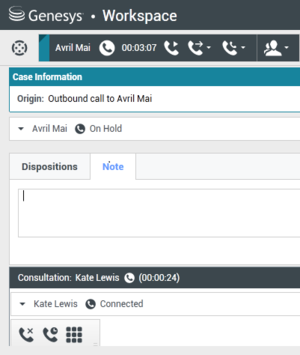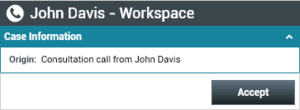Handle A Voice Consultation
In this lesson, you will learn how to use the Team Communicator feature to find an internal target (such as an agent, Routing Point, or queue) or a contact and start a voice consultation from an interaction window, such as voice, email, and chat. You can also use the first procedure in this lesson to find a contact and start a voice consultation. The second section demonstrates how to handle a Voice Consultation request.
The Team Communicator enables you to find an internal target or a contact, send an Instant Message (IM) to an internal target, call an internal target or a contact, initiate a conference or consultation, or transfer a call.
This lesson contains the following sections:
Starting a Voice Consultation
The Workspace Voice, Email, and Chat Interaction windows enable you to start a voice, chat, or instant messaging consultation with an internal target or a contact about your current interaction (see Lesson: Handle A Voice Call), email interaction (see Lesson: Handle An Email Interaction), or chat interaction (see Lesson: Handle a Chat Interaction).
Workspace also enables you to instantly transfer or conference your call with an internal target or a contact. You can do this with or without first starting a consultation. For instant transfers, the call is transferred as soon as the other party accepts the interaction. For instant conferences, the conference starts as soon as the other party accepts the interaction.
Lesson: Starting a voice consultation
Purpose: To find an internal target (such as an agent, Routing Point, or queue), and then start a voice consultation.
Prerequisites
- You are logged in to Workspace (see Lesson: Logging in to Workspace).
- You have an active interaction with a contact (see Receiving a Voice Interaction, Receiving and Handling an Inbound Email Interaction, or Receiving and Handling an Inbound Chat Interaction).
Start
- In the active interaction window, click the Start Consultation button to open the Team Communicator (see the Finding an internal target for a voice consultation in the active Voice Interaction window figure for an example of a voice interaction).
- Use the Team Communicator to find the internal target with whom you want to start a consultation (see the Lesson: Using the Team Communicator feature to find an internal target).
- Click the Action Menu drop-down list is displayed next to the name of the internal target with whom you want to consult, and then select Start Voice Consultation (see the Start Voice Consultation menu option figure). The contact is put on hold. When the internal target accepts the interaction request, you can speak to the internal target agent. If the consultation target does not accept your request, the consultation request is released, but your contact might still be on hold. You must click the Resume Call button to take your contact off hold.
- When you are connected to your consultation target, the internal target is added to the Workspace Interaction window (see the Voice Interaction window, displaying a consultation call that is connected to the internal target while the contact party is on hold figure).
- During your consultation, you can alternate between the contact and the consulting party by clicking the Resume Call button. Doing this puts the active party on hold and connects you to the other party. During your consultation, you can start a conference with your consultation target or another target (see Starting a Voice Conference).
- To end your consultation, click End Call. Your consultation target might also end the call.
[Added: 8.5.103.10]TipDepending on how your system is configured, when you end the call with the consultation target you might automatically be reconnected with the contact who was on hold or you might have to manually reconnect the call by clicking Resume (
 ). The manual reconnect feature enables you to make another consultation call without being reconnected and having to put the contact on hold again.
). The manual reconnect feature enables you to make another consultation call without being reconnected and having to put the contact on hold again.
End
Receiving a Voice Consultation
The Workspace Voice, Email, and Chat Interaction windows enable you to receive a voice, chat, or instant messaging consultation with an internal target.
Workspace also enables agents to instantly transfer or conference calls to you. Agents can do this with or without first starting a consultation. For instant transfers, the call is transferred as soon as you accept the interaction. For instant conferences, the conference starts as soon as you accept the interaction.
Lesson: Receiving a voice consultation request
Purpose: Receive an invitation to a consult about a voice interaction from another agent to provide assistance to that agent in completing an active interaction.
Prerequisites
- You are logged in to Workspace (see Lesson: Logging in to Workspace).
- Your status is Ready for the voice-media channel (see Lesson: Going Ready in the Workspace Main window).
- You are the internal target for the voice consultation interaction.
Start
- Your hard phone or soft phone rings, and a preview of the inbound interaction is displayed on your workstation desktop in an interactive notification window (see the Voice Interaction Consult Preview interactive notification figure).
The Interaction Preview contains a summary of information about the call with the contact and the identity of the agent that is requesting consultation. The Interaction Preview might also contain Case Information, which is part of the case data regarding the call.
TipIf you are using a screen reader, your system might be configured to give the focus to the Interaction Preview window. In this scenario, your screen reader will automatically read the window title to you. Navigate to the content area to have your screen reader read the Interaction Preview content. However, if your system is not configured to give the focus to the Interaction Preview window, to have your screen reader read the contents of the Interaction Preview window, you must use screen navigation to give the focus to the Interaction Preview. (Added: 8.5.101.14) - You can choose to accept or reject the interaction in the Interaction Preview by performing one of the followings steps:
- Click Accept to answer the consultation interaction.
- Do nothing. The interaction will time-out.
- If you accept the interaction, the call is answered in your hard phone or soft phone, and the Voice Consultation Interaction window is displayed (see the Voice Consultation Interaction window figure).
You can use the Voice Consultation Interaction window to do the following:
- View contact records. See Lesson: Finding and viewing an interaction in the contact database.
- View contact history. See Managing Contact History.
- Launch the Team Communicator. See Starting a Voice Conference, Transferring a Voice Call, and Blending a voice consultation with an IM consultation.
- View the case data for the interaction. See Managing Contact History.
- Link to a web-page from a hyperlink in the Case Information view. The case information might contain a hyperlink to enable you to view a web-page that is related to the interaction, such as customer records. Click the hyperlink in the Case Information view to open a new browser window and view the link. Place your mouse pointer over the hyperlink to preview the web page from the Case Information view. The hyperlink might be a URL or highlighted anchor text.
- If you connect successfully with the agent that is requesting a consultation, you can do any of the following:
- Terminate the call (see Step 5).
- Put the call on hold and retrieve the call. The call status changes to On Hold, and then back to Connected when you retrieve the call.
- Use the keypad to send DTMF to the contact.
- Start a voice or IM consultation.
- Conference the call (see Starting a Voice Conference).
- Transfer the call (see Transferring a Voice Call).
- View and read standard responses (see Lesson: Using The Standard Response Library).
- For SIP enabled agents, additional call actions are available:
- Record the call (see Record Interactions).
- Mute and unmute the call.
- Adjust the microphone and speaker volumes.
Note: For information about how to use the functionality in the interaction window, see the Workspace 8.5 Help.
- When the interaction is complete, either you or the agent can end the call.
If you want to terminate the call, click the End Call button. - The Voice Interaction window closes automatically. You do not have to click Mark Done or set a disposition for a consultation call that you have received.
End
Next Steps
- Set your status to Ready. See Lesson: Going Ready in the Workspace Main window.





